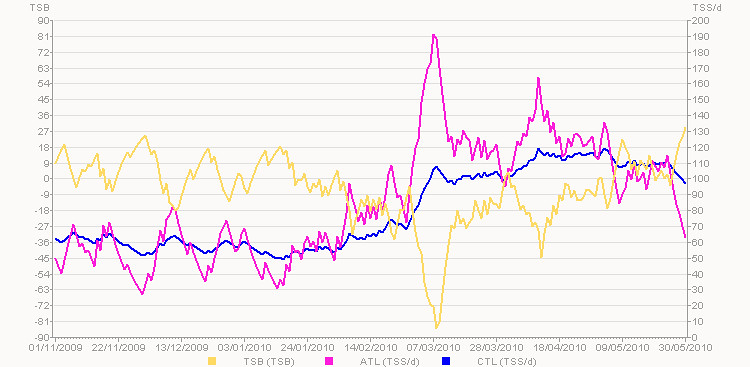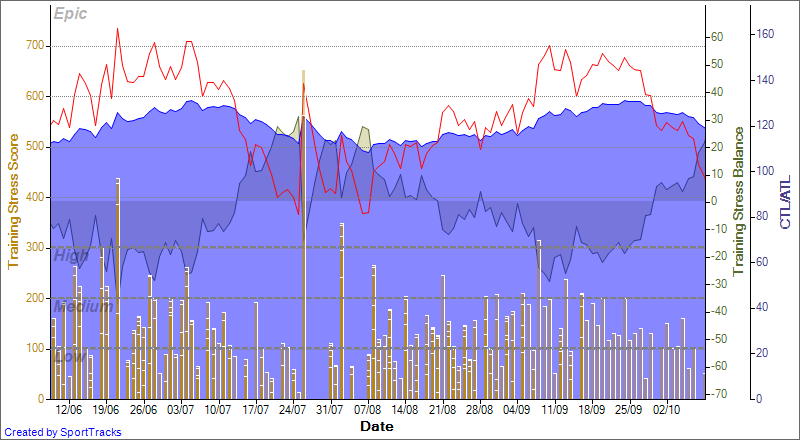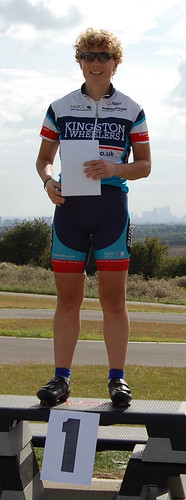
My dwindling fitness graphically portrayed, thanks to some unscheduled downtime.
After our 10-day monster training camp in Lanzarote in early March (blog post about that still to come), I carried some pretty great form and fitness straight through til the Bedford stage race two months later. Well... to be fair, that form was starting to get somewhat ragged around the edges by then, and as a former "big event" triathlete I wasn't quite sure what to do about it. My years of training until this year have been based on the train hard, train harder, train so hard you're dead, taper/rest, then race schedule that I really had no idea how to approach this week-in week-out constant training and racing. How does one maintain fitness without too much fatigue and still have good form for races? So after Bedford I decided the best way to hang on to my form yet stay fresh was to forego the weekly long rides and stick mostly to shorter stuff, either as races or faster training rides. After all, the longest non-TT race I'll do this year will be less than three hours, so why the need for 100 mile training rides?
So with a CTL hovering nicely around 110 and TSB plus or minus a few digits, I settled in these past few weeks to that plan. And while it seemed to be working in terms of freshness and fatigue balancing into some semblance of form, I still was missing that zip in my legs that I had back in mid-April. I wasn't awesome when I wanted to be; form in races seemed to come and go when it felt like it. Thursday night handicap AKA training race? Great performance! Southeast road race divisional championships? Meh. Crystal Palace saw me relying more on good position and timing than on good legs, and the National 10 mile TT last weekend could barely garner FTP watts. What to do?
Then, a crash a week ago Friday (bringing with it some unwelcome road rash and bruises) made the link between my body's fatigue and freshness even more tenuous, and finally last Tuesday the saddle sore I'd been carefully nursing for the past few weeks was no longer a minor annoyance. So as a result I've been off the bike for six days with at least another two to come before I dare try my luck matching arse to saddle again.
I've been trying to find a bright side to this as I watch my CTL drop like a stone with every passing day, now below the level it was when I finished the training camp in March. And I think it's this: downtime isn't necessarily a bad thing. The timing isn't catastrophic. I'm not truly sick or injured, so building my fitness back up shouldn't be an issue. My peak from the last major build came about six weeks later, and looking at the calendar, the same timing now should mean good form for the Essex Giro national series race at the end of July. So in the end I think I've answered my question about form and fitness and how one races all summer long trying to hold a peak: you don't. At some point you just have to let it go, take a rest, then work to build it up again. I mean, I could race 12 months a year non-stop, but I suspect I'd just end up frustrated that I never felt 100% fresh and zippy. Some downtime, unscheduled or not, is required.
Now I just need to figure out how to make the races that count your best ones... but I have a sneaking suspicion the answer will be much the same. This is a big reason why I love cycling: there's just so much that can't be predicted, though we data geeks sure love to try.


